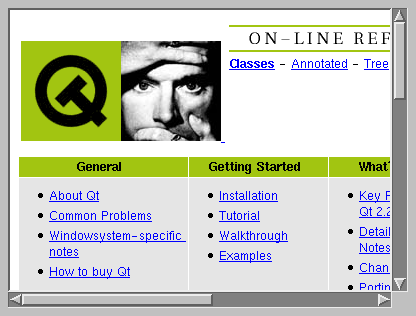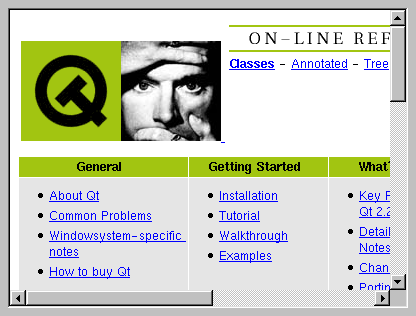| Home | All Classes | Main Classes | Annotated | Grouped Classes | Functions |
The TQTextBrowser class provides a rich text browser with hypertext navigation. More...
#include <ntqtextbrowser.h>
Inherits TQTextEdit.
This class extends TQTextEdit (in read-only mode), adding some navigation functionality so that users can follow links in hypertext documents. The contents of TQTextEdit is set with setText(), but TQTextBrowser has an additional function, setSource(), which makes it possible to set the text to a named document. The name is looked up in the text view's mime source factory. If a document name ends with an anchor (for example, "#anchor"), the text browser automatically scrolls to that position (using scrollToAnchor()). When the user clicks on a hyperlink, the browser will call setSource() itself, with the link's href value as argument. You can track the current source by connetion to the sourceChanged() signal.
TQTextBrowser provides backward() and forward() slots which you can use to implement Back and Forward buttons. The home() slot sets the text to the very first document displayed. The linkClicked() signal is emitted when the user clicks a link.
By using TQTextEdit::setMimeSourceFactory() you can provide your own subclass of TQMimeSourceFactory. This makes it possible to access data from anywhere, for example from a network or from a database. See TQMimeSourceFactory::data() for details.
If you intend using the mime factory to read the data directly from the file system, you may have to specify the encoding for the file extension you are using. For example:
mimeSourceFactory()->setExtensionType("qml", "text/utf8");
This is to ensure that the factory is able to resolve the document
names.
TQTextBrowser interprets the tags it processes in accordance with the default style sheet. Change the style sheet with setStyleSheet(); see TQStyleSheet for details.
If you want to provide your users with editable rich text use TQTextEdit. If you want a text browser without hypertext navigation use TQTextEdit, and use TQTextEdit::setReadOnly() to disable editing. If you just need to display a small piece of rich text use TQSimpleRichText or TQLabel.


See also Advanced Widgets, Help System, and Text Related Classes.
This signal is emitted when the user clicks an anchor. The link is the value of the href i.e. the name of the target document. The name is the name of the anchor.
See also linkClicked().
See also forward() and backwardAvailable().
Example: helpviewer/helpwindow.cpp.
This signal is emitted when the availability of backward() changes. available is FALSE when the user is at home(); otherwise it is TRUE.
Example: helpviewer/helpwindow.cpp.
See also backward() and forwardAvailable().
Example: helpviewer/helpwindow.cpp.
This signal is emitted when the availability of forward() changes. available is TRUE after the user navigates backward() and FALSE when the user navigates or goes forward().
Example: helpviewer/helpwindow.cpp.
This signal is emitted when the user has selected but not activated a link in the document. link is the value of the href i.e. the name of the target document.
Example: helpviewer/helpwindow.cpp.
Example: helpviewer/helpwindow.cpp.
| Keypress | Action |
|---|---|
| Alt+Left Arrow | backward() |
| Alt+Right Arrow | forward() |
| Alt+Up Arrow | home() |
Reimplemented from TQTextEdit.
This signal is emitted when the user clicks a link. The link is the value of the href i.e. the name of the target document.
The link will be the absolute location of the document, based on the value of the anchor's href tag and the current context of the document.
See also anchorClicked() and context().
Sets the name of the displayed document to name. See the "source" property for details.
Returns the name of the displayed document. See the "source" property for details.
This signal is emitted when the mime source has changed, src being the new source.
Source changes happen both programmatically when calling setSource(), forward(), backword() or home() or when the user clicks on links or presses the equivalent key sequences.
Example: helpviewer/helpwindow.cpp.
This property holds whether the contents have been modified.
This property holds this text browser's overwrite mode.
This property holds whether the contents are read only.
This property holds the name of the displayed document.
This is a TQString::null if no document is displayed or if the source is unknown.
Setting this property uses the mimeSourceFactory() to lookup the named document. It also checks for optional anchors and scrolls the document accordingly.
If the first tag in the document is <qt type=detail>, the document is displayed as a popup rather than as new document in the browser window itself. Otherwise, the document is displayed normally in the text browser with the text set to the contents of the named document with setText().
If you are using the filesystem access capabilities of the mime source factory, you must ensure that the factory knows about the encoding of specified files; otherwise no data will be available. The default factory handles a couple of common file extensions such as *.html and *.txt with reasonable defaults. See TQMimeSourceFactory::data() for details.
Set this property's value with setSource() and get this property's value with source().
This property holds this text browser's undo depth.
This property holds whether undo and redo are enabled.
This file is part of the TQt toolkit. Copyright © 1995-2007 Trolltech. All Rights Reserved.
| Copyright © 2007 Trolltech | Trademarks | TQt 3.3.8
|